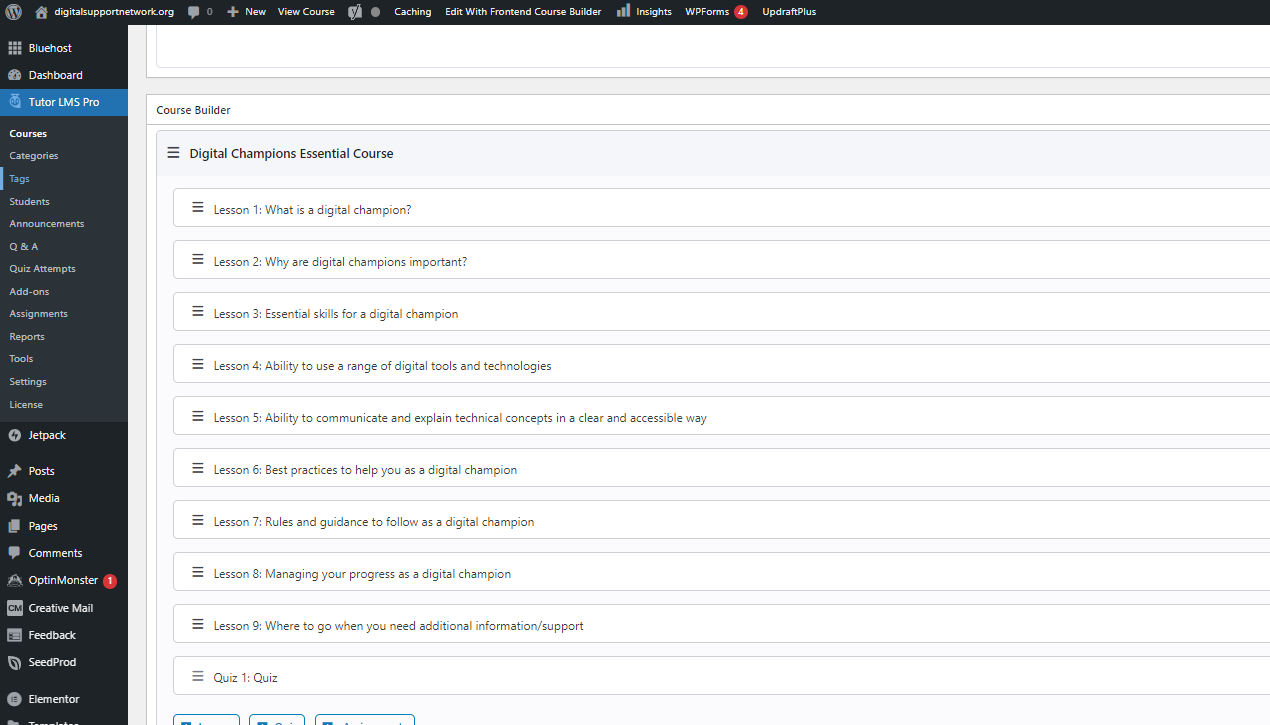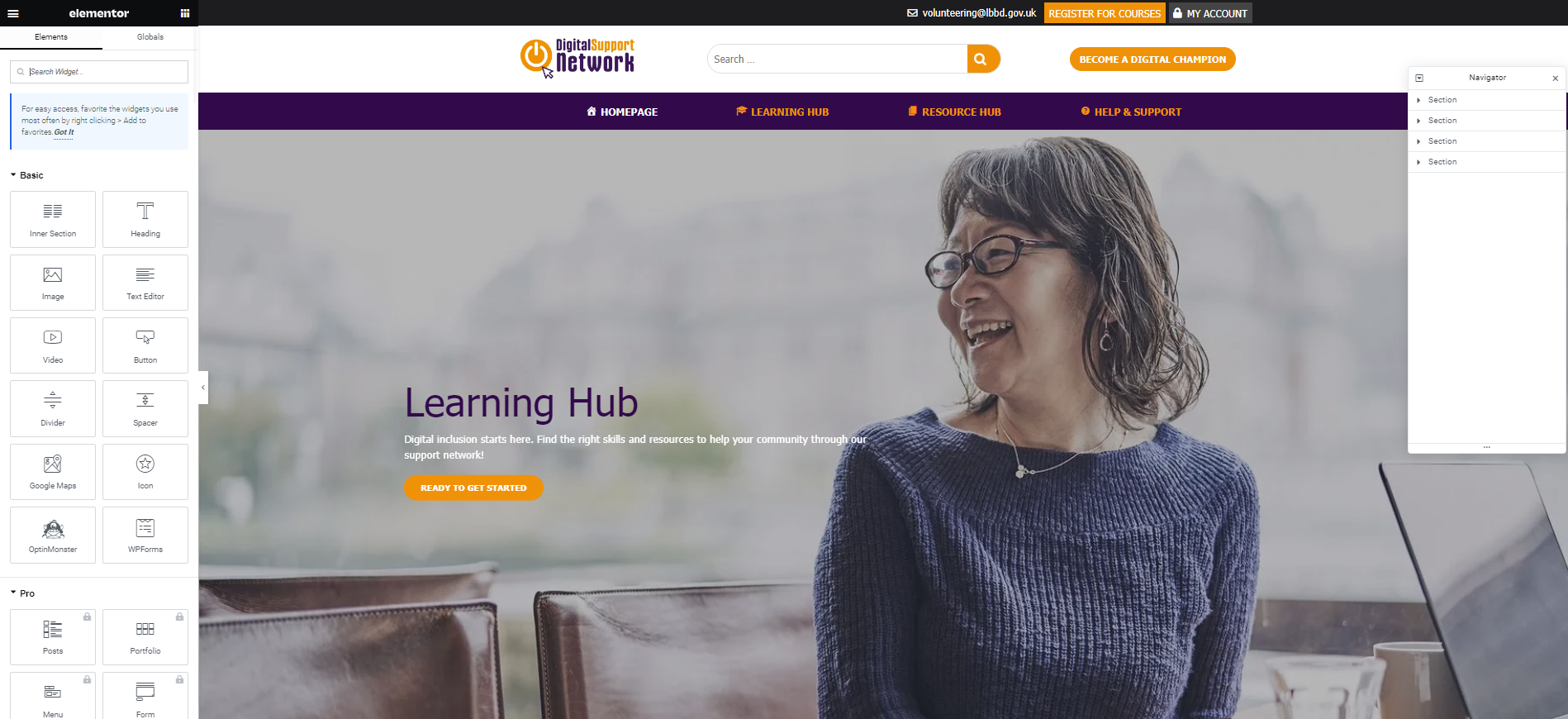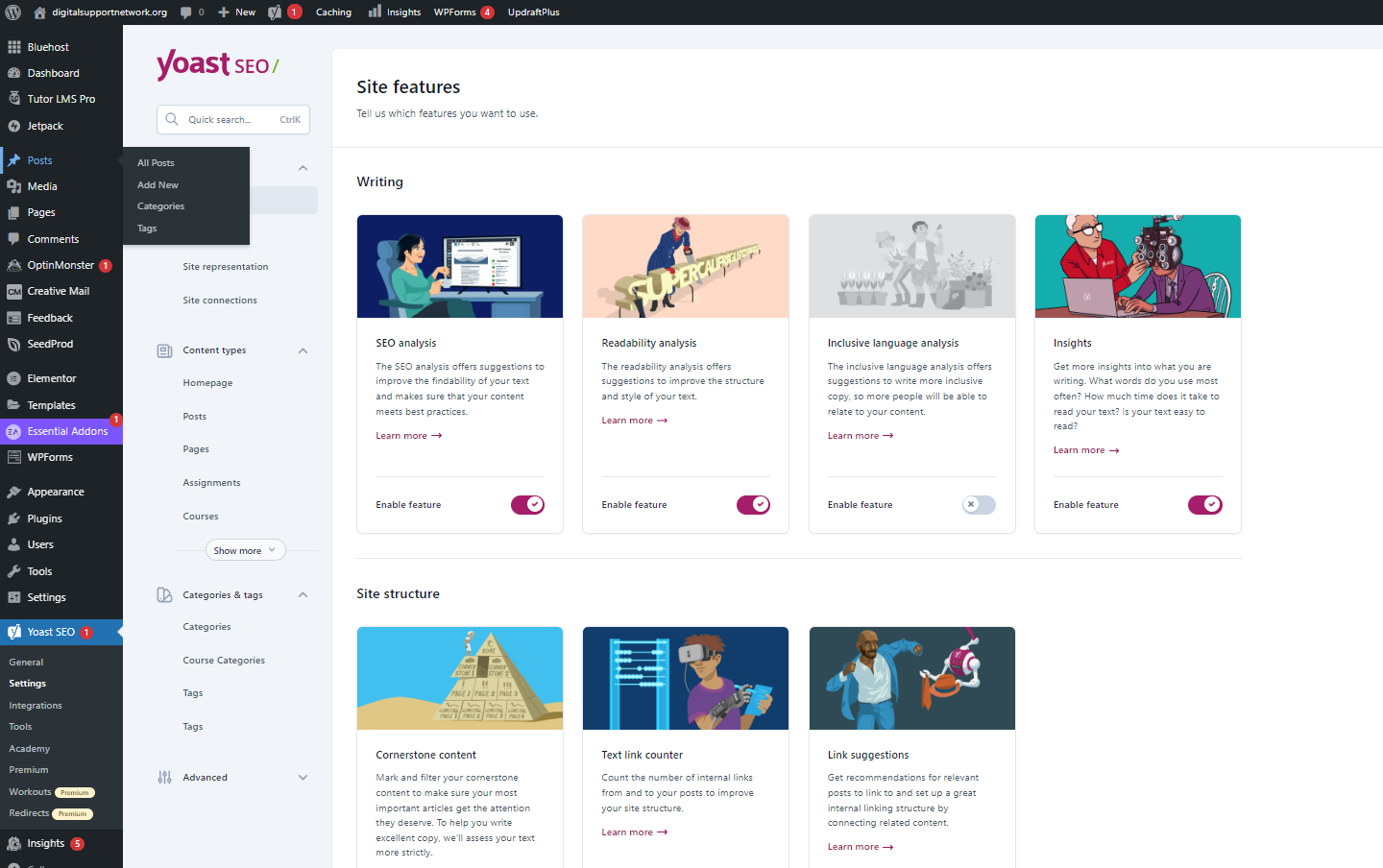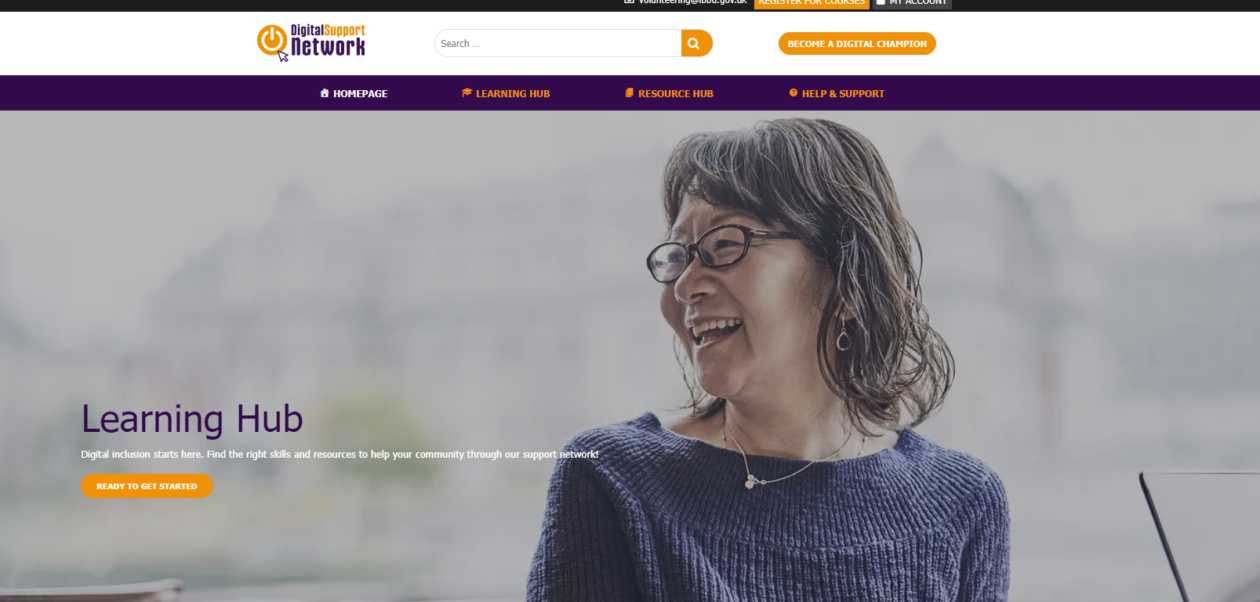The purpose of this documentation is to provide a comprehensive guide for other councils, empowering them to replicate the success of the Digital Support Network website in their own communities. We’re hoping that our process serves as a valuable resource for council officials, web developers, and stakeholders involved in digital inclusion initiatives.
Our website solution offers a powerful tool to bridge the digital divide within communities. By providing a centralised platform for digital inclusion efforts, councils can reach and support digitally excluded individuals more effectively. This, in turn, empowers individuals to access online services, engage in digital activities, and develop essential digital skills.
Our Team:
Our collaborative and skilled team were at the core of our project’s success. Comprising a UX designer, content designers, and a delivery lead, each member played a vital role in driving the project forward and achieving our goals. Here is how each team member collectively contributed to the project’s success:
- UX Designer: Through user research, persona development, information architecture, wireframing, prototyping, and usability testing, our UX designer ensured that our digital inclusion project met the needs and expectations of our target audience. Collaborating closely with other team members, the UX designer brought user-centered design principles to the forefront, shaping the project’s success.
- Content Designers: Our content designers played a pivotal role in crafting engaging content. They skillfully curated and created content that resonated with our users and aligned with the project objectives, this included the online courses accessible to our Digital Champions. Their collaboration with other team members resulted in a cohesive and impactful digital learning experience.
- Delivery Lead: Our delivery lead was the driving force behind the project’s execution and successful completion. They provided guidance and leadership, overseeing timelines, resource allocation, and coordination of team efforts. By managing project milestones, facilitating effective communication, and ensuring efficient project delivery, the delivery lead played a crucial role in keeping the project on track and meeting objectives.
Project setup and process:
Our project setup and planning revolved around establishing clear goals, involving stakeholders, and following an iterative cycle of research, design, and evaluation. Additionally, we adopted a collaborative approach, utilising effective team structures and leveraging collaboration tools and methodologies.
We carefully planned the project timeline, taking into account the various stages such as research, design, development, testing, and iterations. Each stage had allocated time frames and milestones to ensure timely completion and allow for necessary adjustments based on feedback and insights gained throughout the project.
During the initial project setup, we identified key stakeholders who play a crucial role in the success of our digital inclusion project. These stakeholders included volunteers and our volunteer management team. By involving them from the start, we ensured that their perspectives and needs were considered throughout the project lifecycle.
To guide our project, we established specific goals and objectives. We conducted a thorough discovery phase, consisting of research, interviews, and workshops with our volunteers and workers. This phase helped us gain insights into the challenges they face and allowed us to define problem statements, user profiles, and user needs. By identifying their pain points and frustrations with Digital Unite, we were able to determine areas for improvement and set clear objectives to address these issues in our new website. Some of the pain points that were identified were the following:
- Lack of filter options
- Content that isn’t specific to the London Borough of Barking and Dagenham
- Inaccurate search results
- Content not being arranged in the most user friendly way
- Online courses aren’t intuitive enough
Based on this information, we set clear objectives to address these pain points and create a solution that meets the needs of our target audience.
Branding:
We successfully customised the website to align with the branding and visual identity of our project. As a first step, we conducted meetings with our Communications Team to gain a better understanding of our branding guidelines and specific requirements for the website. This collaboration allowed us to gain insights into the preferred visual elements, messaging, and overall brand identity that needed to be reflected in the website customisation.
Based on the guidance provided by the Communications Team and our thorough research, we selected an orange, purple, and white colour scheme. The team’s input helped us understand the council’s desired emotional associations and their vision for the website’s visual impact. The orange colour represented energy, enthusiasm, and creativity, aligning perfectly with the council’s vibrant and supportive digital initiatives. Purple symbolised wisdom, dignity, and community, reflecting the council’s commitment to inclusivity and empowerment. We also incorporated white as a neutral colour to provide balance, readability, and a modern aesthetic.
During the customisation process, we also recognised the importance of having a unique and representative logo for the website. To achieve this, we collaborated closely with our talented brand designer to create a logo that aligned with the branding and visual identity of the Digital Support Network. The collaboration with the Communications Team, coupled with our research and design expertise, allowed us to create a website that seamlessly extended the London Borough of Barking and Dagenham’s brand online, providing a memorable and engaging user experience.


Deployment and Hosting:
In our website deployment and hosting process, we carefully selected plugins that played a crucial role in creating a robust and user-friendly platform. With WordPress as our content management system, we leveraged the power of plugins to enhance the functionality and performance of our website. Three key plugins – Tutor LMS Pro, Elementor, and Yoast SEO – stood out due to their significance in providing a comprehensive learning experience, customisable interface, and optimised search engine visibility. These plugins played an integral part not only during the deployment and hosting phase but also in our thorough test phase, ensuring the website’s effectiveness and user satisfaction.
TutorLMS Plugin:
The selection of the Tutor LMS Pro plugin was driven by our goal to provide a comprehensive learning environment for our Digital Champions. This robust learning management system plugin facilitated course creation, enrollment management, progress tracking, and assessment functionalities. By integrating Tutor LMS Pro, we ensured that our Digital Champions had access to interactive and engaging courses, boosting their learning outcomes and overall experience on the website. During our test phase, we thoroughly evaluated the plugin’s features, ensuring that it met our requirements for course management and user engagement.

Elementor Plugin:
The Elementor plugin played a pivotal role in our website’s customisation and user interface design. Its intuitive drag-and-drop functionality allowed us to create visually appealing and highly customisable pages without the need for extensive coding knowledge. During our test phase, we explored the plugin’s extensive design elements, templates, and flexibility, ensuring that we could tailor the website’s interface to meet the needs of our users.

Yoast SEO Plugin:
The importance of search engine optimisation (SEO) cannot be overstated when aiming for optimal online visibility. To maximise our website’s search engine performance, we integrated the Yoast SEO plugin. This powerful tool provided us with essential features such as on-page optimisation, XML sitemap generation, meta tag management, and content analysis. By leveraging the capabilities of Yoast SEO, we ensured that our website was optimised for search engine algorithms and achieved better visibility in search engine results.

During the test phase, these plugins were extensively evaluated to ensure their reliability, compatibility, and usability. We conducted thorough testing to verify that they seamlessly integrated with our website, provided the desired functionalities, and enhanced the user experience. Any issues or improvements identified during the test phase were diligently addressed to ensure a seamless and user-friendly platform. By carefully selecting and integrating the Tutor LMS Pro, Elementor, and Yoast SEO plugins, we not only achieved a robust and user-friendly website but also streamlined our test phase to ensure the platform’s effectiveness and user satisfaction.
Collaboration and Engagement Strategies:
In fostering collaboration and engagement within the community through our website, we implemented various strategies to encourage active participation and gather valuable feedback.
To incentivise user participation from our Digital Champions, we recognised the importance of their input in workshops, interviews, and user testing. Understanding the value they brought to the project, we allocated a dedicated budget and offered incentives such as Amazon vouchers. These incentives not only acknowledged their valuable contributions but also motivated them to actively engage throughout the different stages of the project. By ensuring their involvement, we were able to gather insights, feedback, and perspectives that significantly influenced the development and success of our digital inclusion initiative.
Transparency played a crucial role in fostering engagement. To keep stakeholders informed about our progress and the website’s development, we regularly released written content updates on our CX blog. This blog was accessible to both internal staff at the London Borough of Barking and Dagenham and residents within the borough. By sharing our journey and providing updates on milestones, challenges, and achievements, we invited the community to be part of the process. This open and transparent approach not only built trust but also encouraged community members to provide their thoughts, suggestions, and support.
Our team also recognised the importance of collaboration with various board members across the council to ensure alignment with strategic goals and initiatives. To gain their buy-in and foster ongoing discussion, we held regular update meetings with key stakeholders, including the Customer Improvement Board (CIB) and the Digital Inclusion Strategy and Action Group. These meetings provided a platform to share progress, address concerns, and gather valuable input that shaped the direction of the website and our digital inclusion efforts. By involving these stakeholders, we fostered a sense of ownership and collective responsibility for the success of our initiative.
Feedback played a vital role in continuous improvement. During the testing and iteration phases, we actively sought feedback from both Digital Champions and the Volunteer Management Team. Their input was invaluable in identifying areas for refinement and enhancement. By involving them in the branding process, we empowered Digital Champions to contribute to the platform’s identity, allowing them to assist us in selecting the most appropriate name that resonated with the community. This collaborative approach ensured that the website truly represented the needs and aspirations of the digital champions we aimed to serve.
By implementing incentives for participation, maintaining transparency through written content updates, engaging with key stakeholders, actively seeking feedback, and involving Digital Champions in the branding process, we fostered collaboration and engagement within the community through our website. These strategies not only facilitated active participation but also ensured that the website met the needs and expectations of the community it served, establishing a strong foundation for our digital inclusion initiative.
Success Metrics and Measurement:
In measuring the success of the Digital Support Network website, we focused on several key benefits that we aimed to achieve through its development.
A primary goal of the Digital Support Network was to enhance the digital skills of residents in the area. By providing access to digital devices and the internet, we aimed to empower residents to stay connected with friends, learn new skills, and access a wide range of entertainment. The improved digital skills of residents not only enhance their individual life prospects but also contribute to the overall advancement and inclusivity of the community. Digital inclusion has a positive impact on society by increasing employability, fostering higher earnings, and facilitating more productive businesses and public services. These factors collectively contribute to the economic growth and levelling up of the community members.
We also anticipated that the Digital Support Network would lead to a decrease in the number of residents in the borough who are currently offline, estimated at 15,000. This reduction in offline residents would have several positive effects. It would result in a decrease in Contact Centre calls, as more residents would be able to find the information and services they need online. Furthermore, it would lead to an increase in self-serve online form usage, enabling residents to conveniently access and submit forms digitally. Over the long term, this shift toward online engagement would contribute to improving the metrics outlined in our Borough Manifesto, which represents our commitment to the progress and betterment of the community.
In addition to these key benefits, we actively sought and gathered user feedback from our Digital Champions to continually improve the functionalities and features of the website. This feedback was collected through online surveys and interviews, allowing us to gain valuable insights into their experiences and suggestions for enhancement. Moreover, our dedicated team of content designers utilised Google Analytics to track the behaviour of Digital Champions on the website, helping us understand usage patterns, popular features, and areas for improvement. These measurement strategies ensured that we could iteratively enhance the website’s performance and user experience, aligning it more closely with the needs and preferences of our digital champions.
By focusing on these success metrics and measurements, we were able to track the impact and effectiveness of the Digital Support Network website in improving digital skills, reducing offline residents, and continually refining the user experience based on user feedback and analytics data.
Resources:
To initiate the course development process, we began by carefully selecting the courses that we wanted our Digital Champions to explore. Our decision-making process revolved around aligning these courses with the Essential Digital Skills Qualification (EDSQ), as it served as the most reputable and reliable framework for digital skills. The EDSQ framework covers a variety of digital skills, ranging from basic concepts and online safety to communication, finding information, and using digital services. By aligning our courses with the EDSQ, we ensured that our Digital Champions received training in the essential digital skills required to navigate and thrive in today’s digital society.
Next, we worked diligently to create course objectives and quizzes, ensuring that each course provided comprehensive coverage of the identified digital skills. Our content designers and UX designer collaborated closely to formulate engaging and informative courses from scratch. By defining clear objectives, we established the desired learning outcomes for our Digital Champions, empowering them to acquire and deliver these essential digital skills effectively.
To supplement the course content, we extensively researched different resources related to the EDSQ. These resources were carefully selected to equip our Digital Champions with valuable tools and references to support their interactions with residents. We organised and launched these resources in our dedicated “Resource Hub,” ensuring that Digital Champions had easy access to a wide range of digital skill references and materials during their engagements with the community.
The resources we discovered were incredibly helpful in both providing a solid foundation for our course content and offering support to our Digital Champions in their interactions with learners. These resources served as valuable references and materials to enhance the quality of our courses and empower our Digital Champions to effectively deliver digital skills training. Here are some of the resources we found:
- Excellence Gateway: The Excellence Gateway offers a comprehensive range of resources and tools to support the development of digital skills. It provides access to a wealth of information, guidance, and best practices in the field of digital skills development.
- Digital Functional Skills qualifications: This resource offers subject content for Digital Functional Skills qualifications. It provides detailed information and guidelines for teaching and assessing digital skills in line with recognised standards.
- Skills workshop: Skills workshop’s is a valuable resource for educators and learners alike. It offers a wide range of materials, including worksheets, activities, and teaching resources, specifically designed to enhance digital skills across various levels and topics.
- Learn My Way: Learn My Way is an online platform dedicated to helping individuals develop essential digital skills. It offers free courses, resources, and interactive tutorials on various digital topics, catering to learners of all levels and abilities.
These resources proved to be highly beneficial in supporting our Digital Champions and providing them with the necessary tools and references to enhance their digital skills. By utilising these resources, we ensured that our Digital Champions had access to up-to-date and reliable materials to support their interactions with residents and effectively contribute to our digital inclusion initiative.
Can you think of someone that might like this? Why not share…


